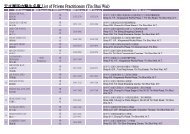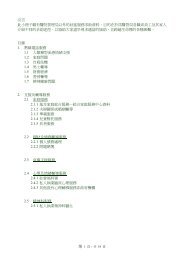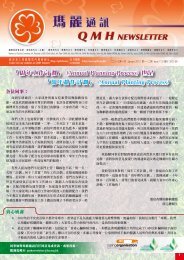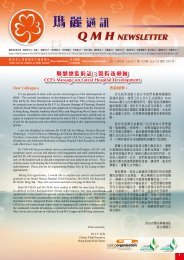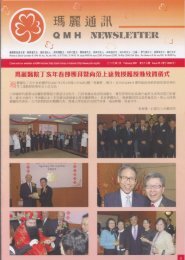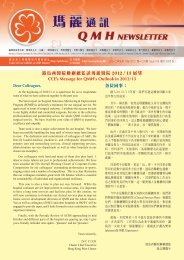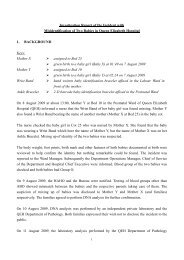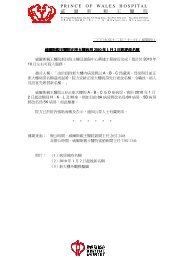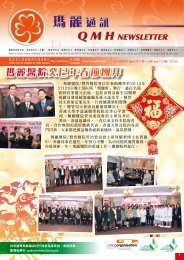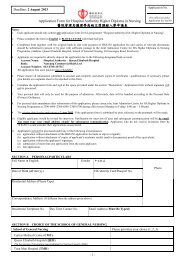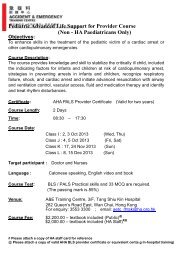2005 Edition Report on Drug Administration Procedure & Practices ...
2005 Edition Report on Drug Administration Procedure & Practices ...
2005 Edition Report on Drug Administration Procedure & Practices ...
You also want an ePaper? Increase the reach of your titles
YUMPU automatically turns print PDFs into web optimized ePapers that Google loves.
GUIDELINES FOR SUPPLY OF MEIDCATIONFOR PATIENTS DURING INTER-HOSPITAL TRANSFERBackgroundThere is currently no laid-down policies in the HA <strong>on</strong> the supply of medicati<strong>on</strong>s forpatients during inter-hospital transfers. Individual discharge or recipient hospitals may or may nothave any agreed arrangements regarding the issue or acquisiti<strong>on</strong> of medicati<strong>on</strong>s for these patients.observed.In a survey c<strong>on</strong>ducted by CPO, several problems relating to such transfers have been1. Disrupti<strong>on</strong> of supply of medicati<strong>on</strong> occurs if a n<strong>on</strong>-formulary drug of the recipient hospitalhas been prescribed and is not issued by the discharging hospital up<strong>on</strong> transfer.2. Disrupti<strong>on</strong> of supply of medicati<strong>on</strong> if the patient transfer is made after Pharmacy openinghours when no drugs accompany the patient up<strong>on</strong> transfer.3. Medicati<strong>on</strong>s issued directly from ward of discharging hospital to ward of recipient hospitaldo not have proper labeling may be in violati<strong>on</strong> of legal requirements.4. If <strong>on</strong>ly items within the <strong>Drug</strong> Formulary of the recipient hospital are allowed to beprescribed up<strong>on</strong> transfer-out, doctors of the originating hospital must be very familiar withthe Formulary of the recipient hospital in order to avoid disrupti<strong>on</strong> of supply of medicinedue to n<strong>on</strong>-formulary items being prescribed.Issues to be c<strong>on</strong>sideredWhen drawing up the Inter-Hospital Transfer Policy, the patient’s benefit must bec<strong>on</strong>sidered as the top priority. C<strong>on</strong>tinuity of supply of medicati<strong>on</strong> must be ensured when workingout details for the procedures for inter-hospital transfer. The operati<strong>on</strong> of the transfer proceduremust be practicable and the financial implicati<strong>on</strong>s, if any, must be worked out between thedischarging and recipient hospitals.Recommendati<strong>on</strong>s1. To simplify the procedure, it is recommended that each inter-hospital transfer can beviewed as a discharged case for the hospital transferring out the patient, and an admissi<strong>on</strong>case for the recipient hospital. It is a shared resp<strong>on</strong>sibility for both the discharge andrecipient hospital to ensure the c<strong>on</strong>tinuity of supply of medicine for the patient.2. A 5-working days’* discharge medicati<strong>on</strong> order covering all the patient’s currentmedicati<strong>on</strong> profile should be written up and sent to the pharmacy of the discharginghospital for dispensing. The 5-working day’s medicati<strong>on</strong> supply would allow ample timefor the pharmacy of the recipient hospital to make arrangement for the c<strong>on</strong>tinued supplyof drugs. For antibiotics or certain rarely used items, the discharge hospital may c<strong>on</strong>siderto prescribe the full course*. If n<strong>on</strong>-formulary drugs have been prescribed, there shouldalso be sufficient time for the pharmacy to c<strong>on</strong>tact the case medical officer for1




